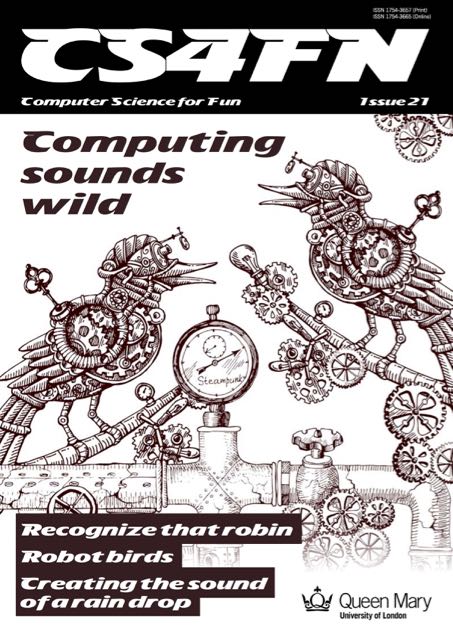A magazine where the digital world meets the real world.
On the web
- Home
- Browse by date
- Browse by topic
- Enter the maze
- Follow our blog
- Follow us on Twitter
- Resources for teachers
- Subscribe
In print
What is cs4fn?
- About us
- Contact us
- Partners
- Privacy and cookies
- Copyright and contributions
- Links to other fun sites
- Complete our questionnaire, give us feedback
Search:
cs4fn Magazine+: Issue 21: Computing Sounds Wild
ISSN 1754-3657 (Print)
ISSN 1754-3665 (Online)
An interest in nature and an interest in computers don’t obviously go well together. For a band of computer scientists interested in sound they very much do, though. Here we explore the work of scientists and engineers using computers to understand, identify and recreate wild sounds, especially those of birds. We see how sophisticated algorithms that allow machines to learn, can help recognize birds even when they can’t be seen, so helping conservation efforts. We see how computer models help biologists understand animal behaviour, and we look at how electronic and computer-generated sounds, having changed music, are now set to change the soundscapes of films. Making electronic sounds is also a great, fun way to become a computer scientist and learn to program.
A pdf version is available to download for free.
Issue 21 of the cs4fn magazine directs you to the web site for more on various articles. Find all the articles as well as linked extras below.
The articles
Learning to sing
What are birds saying?
The vigilance of the flock
Robot birds
Say it sounds like singing
Hugo is no songbird
Mysterious moon music
The chord of Evil
What's that bird? Ask your phone
Making a bird song app
Dawn chorus soundscapes
The doh ray of me
Sophisticated songbird singing
How far can you hear?
Singing bird
A Wookie for 3 minutes
Sonic Pi
The glove that controls your cords...
Pioneering electronic music
Duck, duck, whale
Sea sounds sink ships
Cheap magic
Scale back (page)
Paul Curzon, Dan Stowell, Jane Waite and Peter W McOwan of Queen Mary University of London (QMUL). Summer 2016. In addition to Queen Mary, EPSRC supported this issue through research grants EP/L020505/1 and EP/K009559/1. The issue was also supported by the Mayor of London and Department for Education. cs4fn is a partner on the BBC’s Make It Digital Programme. Spectogram Adelbert Range recording image courtesy of Eddie Game, The Nature Conservancy. The Gympie recording courtesy of Yvonne Philips, Queensland University of Technology (QUT). Sturt recording courtesy of Ecosounds.org. Spectrograms obtained from Michael Towsey, ecosounds.org, QUT.



